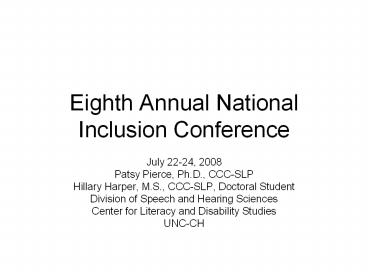Eighth%20Annual%20National%20Inclusion%20Conference PowerPoint PPT Presentation
Title: Eighth%20Annual%20National%20Inclusion%20Conference
1
Eighth Annual National Inclusion Conference
- July 22-24, 2008
- Patsy Pierce, Ph.D., CCC-SLP
- Hillary Harper, M.S., CCC-SLP, Doctoral Student
- Division of Speech and Hearing Sciences
- Center for Literacy and Disability Studies
- UNC-CH
2
Lessons Learned from Year 1
- Including children with significant disabilities
in an Early Reading First project
3
Early Reading First
- On January 8, 2002, the President signed into
law the No Child Left Behind Act of 2001, which
added two important new reading programs to the
Elementary and Secondary Education Act, Reading
First and Early Reading First. Early Reading
First was created to address the growing concern
that many of our nation's children begin
kindergarten without the necessary foundation to
fully benefit from formal school instruction.
4
Early Reading First
- The program supports the development of early
childhood centers of excellence that focus on all
areas of development, especially on the early
language, cognitive, and pre-reading skills that
prepare children for continued school success and
that serve primarily children from low-income
families. - CFDA Number 84.359A 84.359B
5
Research Questions
- (1) Does participation in an ERF classroom lead
to an increase in the number of children who
achieve significant gains on oral language skills
as measured by the Peabody Picture Vocabulary
Test-III, Receptive? - (2) Does participation in an ERF classroom lead
to an increase in the percentage of preschool age
children who demonstrate age-appropriate oral
language skills as measured by the Peabody
Picture Vocabulary Test-III, Receptive?
6
Additional Research Questions
- (3) Does participation in an ERF classroom lead
to an increase in the average number of letters
that preschool age children are able to identify
as measured by the Upper Case Alphabet Knowledge
subtask on the PALS Pre-K assessment? - (4) Does participation in an ERF classroom lead
to an increase in the overall early receptive and
expressive oral language abilities of preschool
age children as measured by the Preschool
Language Scale-4 - (5) Does participation in an ERF classroom lead
to an increase the English Language Proficiency
of preschool age children as measured by the pre-
and post- administration of the Pre-LAS?
7
Richmond County Pubic Schools Early Reading
First Program of Excellence
- Administration
- Linda Nicholson, Federal Programs Haven
Harrelson, Exceptional Children Julie Brigman,
More at Four - ERF Team
- Project Director Teressa Beavers
- Literacy Coaches Corinne Watson, Andrea Kinsey
- Family Liaison Jessica Gonzalez
- UNC-CH
- Professional Development Patsy Pierce, Camille
Catlett, Bonnie Dileone - Evaluation Karen Erickson
- Graduate Research Assistant Hillary Harper
2007-2010
8
Intervention Components
- Head
- Heart
- Hands
9
HeadFoundations NELP Findings
- Thrilling Three B-K
- Oral Language
- Alphabetic Code
- Print Knowledge/
- Concepts
- Five Interventions Code-related, shared reading,
language enhancement, high-quality pre-K, family
involvement (secondary analysis of NELP) - National Center for Family Literacy. (2005).
National early literacy panel Synthesizing the
scientific research on development of early
literacy in young children. Available at
http//www.nifl.gov/partnershipforreading/family/n
cfl/NELP2006Conference.pdf - NELP, 2007-see handout
10
O U T C O M E S
HEART
Comprehension
Fluency
Vocabulary
S T R A T E G I E S
Phonics Intentional Alphabet/Phonological
Awareness Activities
Supports for Emergent Reading/Writing
Rich Oral Language Environments, Play-based
Activities
Ongoing Assessment Family Involvement
11
HandsOWL Curriculum and Specific Intervention
Strategies
- Build on interests using OWL themes and books as
guides - Shared Reading for vocabulary, print concepts,
language - Put the CROWD in the CAR
- Writing for real purposes
12
Year 1 Participants Adults
- Comparision Classrooms
- 4 teachers with Bachelors degree 2 with
Masters Degree - Average number of years of teacher experience
11.3 (range 2-34) - Intervention Classrooms
- 4 teachers with Bachelors degree 1 with
Masters Degree - Average number of years of teacher experience
5.6 (range 3-10) - Classrooms range in size from 6-18 children
13
Teacher/Environmental Measures
- ELLCO (annual pre-post)
- Arnett Scale (annual pre-post)
- Adult-Child Interactive Reading Inventory (annual
pre-post) - Monthly implementation observation
- Teacher Self-Assessment on language and literacy
knowledge/application (11/07 and upon completion
of on-line course)
Please email piercep_at_med.unc.edu if you would
like these references
14
Teacher Self-Assessment Results (pre)
15
Year 1 Classroom Assessment Results Early
Language and Literacy Classroom Observation(pre
and post)
16
Year 1 Classroom Assessment Results Adult-Child
Interactive Reading Inventory(pre and post)
17
Year 1 Classroom Assessment Results Arnett
Scale(pre and post)
18
Year 1 Child Demographics (disability)
19
Year 1 Child Outcomes (pre and post)
n2 for Intervention Group
20
Family Measure
- Home Literacy Inventory (Marvin, C., Ogden, N.
(2002). A home literacy inventory Assessing
young childrens contexts for emergent literacy.
Young Exceptional Children, 5(2), 2-11.)
21
Year 1 Family Data
22
Year 1 Family Data
23
Year 1 Family Data
- Home Literacy Inventory Pretest (2007-2008)
24
Discussion What we think is making the difference
- Differentiated instruction (shared reading
handout) - Curricular infusion with IEPs
- Adaptations
- Materials-see examples book ideas handout
- Curriculum
Note Teachers received over 55 hours of training
on the OWL curriculum and specific strategies
plus at least weekly visits by Literacy Coaches
from January-July, 2008
25
Example for OWL Curriculum
Teacher Directed Activities Interactions
Activity Page IEP Goal (s) Vocabulary Building Block Vocabulary Possible Spanish Vocabulary Possible Accommodations
Soap Bubbles with Colored Water 12 E. 1 E. 2 B. 11 B. 112 B. 111 bubbles, soap, color, food coloring, eggbeater, ice cream, whipped cream, pour, whisk Pop, blow Fun, colors, higher (families suggest) Battery operated bubble gun/switch battery-operated drink mixer/switch blowing bubbles communication board
26
Year 2
- We are expecting more children to be at 85 SS or
below on measures at the beginning of the year
than were at the middle of the year - We are going to continue to concentrate on
developing conversation and shared reading
abilities with adults and ALL children - We are going to offer additional family supports.
27
Any Questions?
hillary_harper_at_med.unc.edu piercep_at_med.unc.edu

